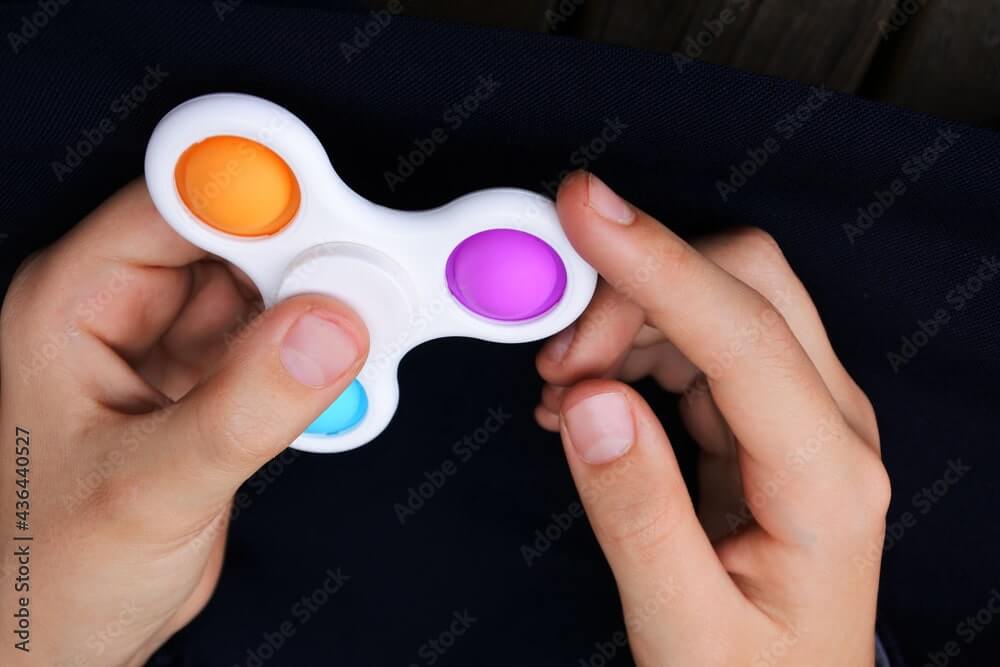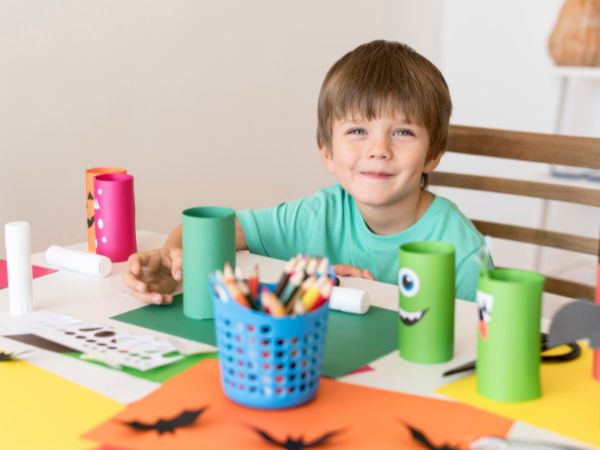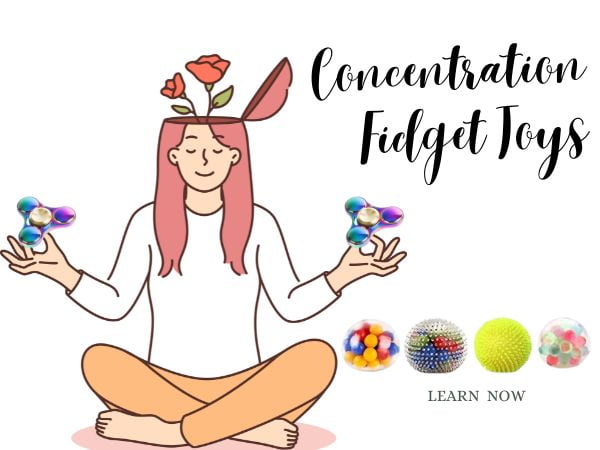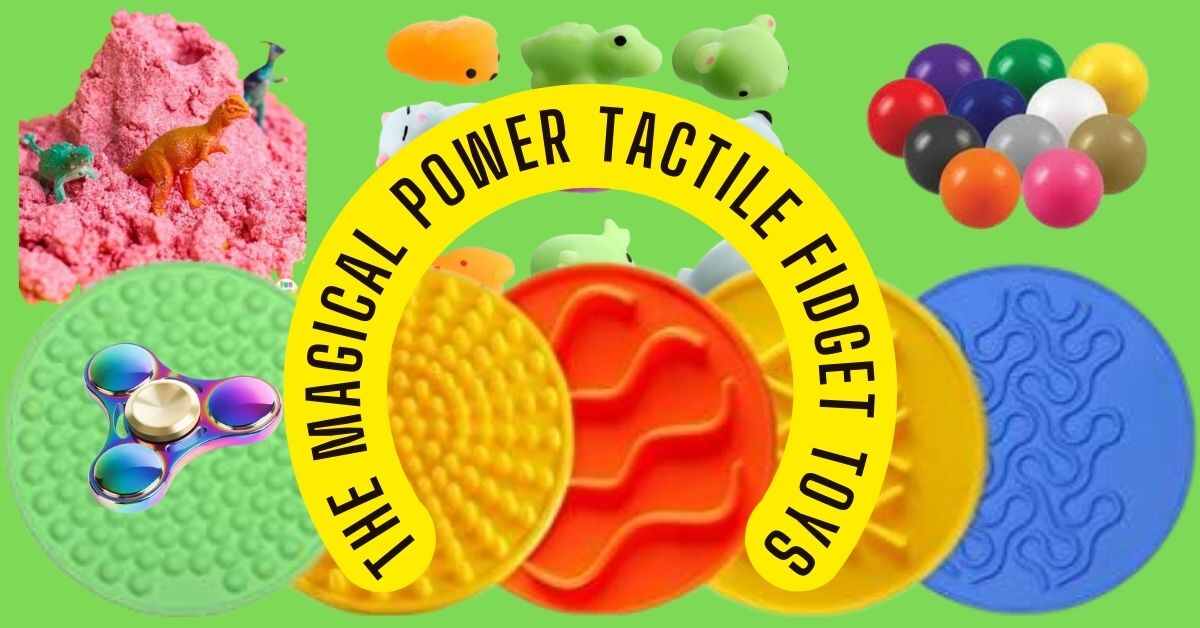Introduction
Living with Obsessive-Compulsive Disorder (OCD) can be challenging, especially during moments of restlessness and anxiety. Finding healthy coping mechanisms is crucial, and one effective solution is using fidget toys. In this article, we’ll explore the best fidget toys tailored to individuals with OCD.
Table of Contents
Understanding OCD and Its Challenges
What is OCD?
A mental health illness known as obsessive-compulsive disorder (OCD) is characterized by uncontrollable, recurrent thoughts (obsessions) and compulsive activities (compulsions).

The Daily Struggles
Individuals with OCD often face challenges in managing their anxiety and restlessness. These moments can be overwhelming and impact their daily lives.
What Calms Down OCD?
While fidget toys can provide comfort and relief for individuals with OCD, it’s important to note that they are not a substitute for professional treatment.
OCD is a complex mental health condition that often requires a comprehensive approach involving therapy and, in some cases, medication.
However, fidget toys can be a helpful tool in managing anxiety and restlessness associated with OCD.
How Do I Relax My Brain for OCD?
Relaxing the brain for OCD involves finding strategies and techniques that help reduce anxiety and promote a sense of calm. Here are some techniques that may be helpful:
- Deep Breathing: Practice deep breathing exercises to slow down your breathing and activate the body’s relaxation response. Take a slow, deep breath in with your nose, hold it for a moment, and then slowly let it out through your mouth.
- Progressive Muscle Relaxation: This technique involves systematically tensing and relaxing different muscle groups in the body to release physical tension. Start with your toes and work your way up to your head, tensing and then relaxing each muscle group.
- Mindfulness Meditation: Engage in mindfulness meditation to bring your attention to the present moment and cultivate a non-judgmental awareness of your thoughts and feelings. This can help reduce anxiety and increase overall relaxation.
- Guided Imagery: Use guided imagery exercises to create a mental image of a peaceful and calming place. Close your eyes, imagine yourself in this place, and focus on the sensory details to enhance relaxation.
- Physical Exercise: Engage in regular physical exercise, such as walking, jogging, or yoga, as it can help release endorphins and reduce anxiety. Choose an activity that you enjoy and make it a part of your routine.
- Journaling: Write down your thoughts and feelings in a journal to help release them from your mind. This can provide a sense of relief and help you gain perspective on your OCD-related concerns.
- Engage in Relaxing Activities: Find activities that you enjoy and that help you relax, such as listening to calming music, taking a warm bath, reading a book, or engaging in a hobby or creative outlet.
- Seek Support: Reach out to a therapist or support group specializing in OCD to learn coping strategies and techniques specific to your condition.

Do Kids Grow Out of OCD?
OCD is a persistent mental illness that necessitates continual management and therapy. Children with OCD can considerably benefit from early intervention and appropriate treatment, such as cognitive-behavioral therapy (CBT).
Children who use CBT learn to identify and resist obsessive thoughts, while those who use ERP exercises lessen compulsive behaviors.
To track development and alter treatment as necessary, it is advised that regular follow-up appointments with a mental health expert be made.
Will I Pass OCD to My Child?
OCD, a genetically predisposed illness, is not a given. Having OCD in the family can increase the likelihood of developing the disorder, but it does not ensure it.
The development of it is also influenced by the environment and personal experiences. It’s critical to be aware of potential risk factors and seek the advice and full evaluation of a healthcare expert.
How Can I Beat OCD Naturally?
While there is no cure for OCD, there are several natural strategies that can help manage and reduce OCD symptoms. Here are some techniques that may be helpful:
- Psychoeducation: Educate yourself about OCD to better understand the condition and its underlying mechanisms. Learning about OCD can help you challenge irrational thoughts and develop a more realistic perspective.
- Cognitive-Behavioral Therapy (CBT): CBT is the most effective form of treatment for OCD. It involves working with a therapist to identify and challenge negative thought patterns and engage in exposure and response prevention (ERP) exercises.
- Mindfulness and Meditation: Practicing mindfulness and meditation can help you develop a non-judgmental awareness of your thoughts and feelings. This can enable you to observe and let go of intrusive thoughts without getting caught up in them.
- Regular Exercise: Engaging in regular physical exercise, such as walking, jogging, or yoga, can help reduce anxiety and improve overall well-being. Exercise releases endorphins, which can boost mood and reduce OCD symptoms.
- Stress Management: Find healthy ways to manage stress, such as deep breathing exercises, progressive muscle relaxation, or engaging in activities you enjoy. Reducing overall stress levels can help alleviate OCD symptoms.
- Healthy Lifestyle: Maintain a healthy lifestyle by getting enough sleep, eating a balanced diet, and avoiding excessive caffeine or alcohol.
- Support Network: Seek support from friends, family, or support groups who understand and can provide empathy and encouragement.
- Limiting Triggers: Identify and reduce triggers that worsen your OCD symptoms. This may involve avoiding certain situations, people, or environments that heighten anxiety and trigger obsessive thoughts or compulsive behaviors.
It’s important to note that natural strategies may not be sufficient for everyone, and it’s advisable to consult with a mental health professional for a comprehensive evaluation and personalized treatment plan. They can provide guidance, support, and additional interventions tailored to your specific needs.
What is the Best Exercise for OCD?
There is no one-size-fits-all answer to what the best exercise for OCD is, as it can vary from person to person.
However, any form of exercise that you enjoy and can regularly engage in can be beneficial in managing OCD symptoms.
Here are a few types of exercise that may be helpful:
- Aerobic Exercise: Activities that get your heart rate up, such as jogging, swimming, cycling, or dancing, can release endorphins and improve mood. Aerobic exercise can also help reduce anxiety and stress, which are often associated with OCD.
- Yoga: Yoga combines physical movement, breath control, and mindfulness, making it a potentially beneficial exercise for managing OCD symptoms. It focuses on relaxation, flexibility, and mindfulness, which can help reduce anxiety and promote a sense of calm.
- Tai Chi: Tai Chi is a gentle form of exercise that involves slow, flowing movements and deep breathing. The meditative aspect of Tai Chi may also promote relaxation and help manage OCD symptoms.
- Mindful Walking: Taking a walk in nature or simply around your neighborhood can be a form of exercise that incorporates mindfulness. Pay attention to the sensations of walking, the sounds around you, and the sights you see.
Ultimately, the best exercise for OCD is one that you enjoy and can incorporate into your routine consistently.
It may be helpful to consult with a healthcare professional or therapist who can provide personalized recommendations based on your specific needs and preferences.
What Foods to Avoid If You Have OCD?
There is no specific diet that has been proven to cure or treat OCD. However, some people with OCD may find that certain foods or dietary habits can trigger or worsen their symptoms.
Here are some foods and dietary habits that may be best to avoid or reduce if you have OCD:
- Caffeine: Caffeine is a stimulant that can increase anxiety and worsen OCD symptoms in some people. It is found in coffee, tea, soda, and chocolate, among other sources.
- Alcohol: Alcohol can also worsen OCD symptoms and increase anxiety. It is best to limit or avoid alcohol consumption if you have OCD.
- Processed Foods: Processed foods, such as fast food, packaged snacks, and sugary drinks, can be high in unhealthy fats, sugar, and salt. These foods can negatively impact overall health and well-being and may contribute to mood swings and anxiety.
- Gluten: Some people with OCD may have gluten sensitivity or celiac disease, which can cause digestive issues and worsen mental health symptoms. If you suspect gluten sensitivity, it may be helpful to avoid gluten-containing foods, such as wheat, barley, and rye.
- High-Fat Foods: A diet high in unhealthy fats can increase inflammation in the body, which may contribute to anxiety and depression.
It is important to note that dietary changes alone may not be sufficient to manage OCD symptoms. It is advised to speak with a medical expert who can offer a thorough assessment and individualized treatment plan. They can assess your individual needs and provide appropriate support and guidance.
What Age Does OCD Peak?
OCD can develop at any age, but there are two age ranges where it tends to peak:
1. Late adolescence to early adulthood: OCD often emerges during late adolescence or early adulthood, typically between the ages of 18 and 24.
This period of life is characterized by significant life changes, increased independence, and higher levels of stress, which can trigger or exacerbate OCD symptoms.
2. Childhood: OCD can also develop in childhood, with the average age of onset being around 10 years old. Children with OCD often experience obsessions and compulsions related to contamination, symmetry, or harm.
Can OCD be Fully Cured?
Obsessive-Compulsive Disorder (OCD) is a chronic disorder, but with correct treatment, many people find significant improvement in their symptoms and can live satisfying lives.
While it cannot be completely cured, good management measures can significantly reduce its impact.
What is the Biggest Symptom of OCD?
The most prominent symptom of Obsessive-Compulsive Disorder (OCD) is the presence of obsessions and compulsions. Obsessions are intrusive, repetitive thoughts or images, while compulsions are repetitive behaviors or mental acts performed in response to these obsessions.
What is the First Stage of OCD?
The appearance of obsessive thoughts is often the initial stage of OCD. These are bothersome and upsetting, forcing people to create rituals or obsessive behaviors to cope with the anxiety generated by the obsessions.
What Are the 4 Stages of OCD?
Obsessive-Compulsive Disorder (OCD) is commonly classified into four stages:
Emergence of an Obsession: The appearance of intrusive, disturbing thoughts or pictures.
Anxiety and Distress: Obsessions cause increased anxiety, pushing people to seek help.
Obsessive Behavior: As a result of the obsessions, rituals or repetitive behaviors emerge.
Temporary Relief: The compulsions provide temporary relief, reinforcing the cycle.
Understanding these stages is essential for effective OCD management and treatment.
What is the Root Cause of OCD?
The exact root cause of Obsessive-Compulsive Disorder (OCD) is unknown, but it is thought to be caused by a mix of genetic, neurological, behavioral, cognitive, and environmental variables. Imbalances in brain chemistry and malfunction in specific brain circuits could also be factors.
Is Overthinking OCD or Anxiety?
Anxiety and Obsessive-Compulsive Disorder (OCD) can cause overthinking. Anxiety can manifest as excessive worry about numerous elements of life. Overthinking in OCD is frequently focused on specific obsessions, leading to compulsive activities in an attempt to relieve anxiety.
Does Yoga Reduce OCD?
Yoga might be a useful supplemental practice for coping with OCD symptoms. Its emphasis on mindfulness, relaxation, and controlled breathing can aid in the reduction of anxiety and the promotion of overall mental well-being, potentially reducing some of the distress associated with OCD.
However, for a full treatment plan, it is critical to see a healthcare specialist.
Is Fidgeting Part of OCD?
Fidgeting is not a distinguishing feature of Obsessive-Compulsive Disorder (OCD). While persons with OCD may fidget as a coping mechanism for anxiety, it is not a primary feature of the illness.
Obsessions and compulsions, which are intrusive thoughts and repetitive behaviors performed in response to those thoughts, are the primary characteristics of OCD.
Can Fidget Toys Help with OCD?
Yes, Fidget toys can be beneficial for people who suffer from OCD. They provide a healthy and useful outlet for excess energy and sensory stimulation, which can help ease the anxiety and restlessness associated with OCD.
Fidget toys, on the other hand, are not a replacement for professional treatment and should be used in conjunction with other approved therapies.
How Do Fidget Toys Help With OCD?
Fidget toys can be beneficial for individuals with OCD by providing a physical outlet for restless or anxious energy. Here are a few ways in which fidget toys may help with OCD:
- Diverting Attention: Fidget toys can help redirect attention away from obsessive thoughts or compulsive urges. Engaging with a fidget toy can provide a sensory distraction that helps break the cycle of rumination or repetitive behaviors.
- Promoting Mindfulness: Fidget toys can serve as a tool for practicing mindfulness. By focusing on the sensations and movements of the toy, individuals can bring their attention to the present moment, reducing anxiety and helping to manage OCD symptoms.
- Providing Sensory Stimulation: Some fidget toys offer different textures, sounds, or movements that can provide sensory stimulation. This can be soothing for individuals with OCD who may experience sensory sensitivities or seek sensory input as a way to manage anxiety.
- Channeling Energy: Fidget toys provide a physical outlet for restless energy, which can be common in individuals with OCD. Engaging with a fidget toy can help channel that energy in a productive and non-disruptive way.
It’s important to note that while fidget toys can be helpful for some individuals with OCD, they may not be effective for everyone.
Different strategies and interventions work for different people, so it’s recommended to consult with a mental health professional who can provide personalized guidance and support for managing OCD symptoms.
Best Fidget Toys for OCD
1. Fidget Spinner: A Classic Choice
The fidget spinner is a simple yet effective toy that provides a soothing sensory experience. Its repetitive motion can help calm anxious minds.

2. Squishy Stress Balls: Squeezable Comfort
These soft, squeezable balls offer a tactile experience, allowing individuals to release tension through gentle squeezing.

3. Twiddle Cube: Multifaceted Distraction
The twiddle cube features various buttons, switches, and textures to engage different senses, making it an excellent tool for redirection.

4. Chewable Jewelry: Sensory Soothers
Chewable jewelry offers a discreet way to address oral sensory needs, providing comfort and reducing anxiety.

5. Tangle Relax Therapy: Endless Manipulation
The Tangle Relax Therapy toy offers a twistable, textured surface for continuous manipulation, helping individuals stay grounded.

6. Fidget Pad: Multi-Sensory Engagement
With buttons, switches, and rollers, the fidget pad provides a range of sensory experiences, making it ideal for those seeking variety.

7. Liquid Motion Bubbler: Mesmerizing Visuals
This captivating toy offers a soothing visual experience as colorful bubbles cascade through a liquid-filled chamber.

Remember, the effectiveness of fidget toys can vary from person to person. It’s important to find the fidget toys that work best for you and provide the most relief from OCD symptoms.
Consulting with a mental health professional can also help in determining the most suitable fidget toys for your specific needs.
Tips for Choosing the Right Fidget Toys for OCD
Living with Obsessive-Compulsive Disorder (OCD) comes with unique challenges, and finding the right fidget toy can be a valuable coping strategy.
Here are some tips to consider when selecting a fidget toy tailored to individuals with OCD:
1. Sensory Preferences Matter
Take into account the individual’s sensory preferences. Some may find comfort in tactile sensations, while others may benefit from visual or auditory stimuli. Choose a fidget toy that aligns with their specific sensory needs.
2. Texture and Material
Consider the texture and material of the fidget toy. Some individuals may prefer soft, squeezable options like stress balls, while others may find relief in toys with textured surfaces or smooth, soothing motions.
3. Size and Portability
Choose a fidget toy that is convenient to carry and use in various settings. Portable options like fidget spinners or small sensory tools can be discreetly used in public spaces or during work or school activities.
4. Safety First
Ensure the selected fidget toy is safe for use, especially if it will be used by children. A choking hazard from toys with small parts should be avoided.
5. Variety of Options
Offer a selection of fidget toys to cater to different needs and preferences. Having a variety allows the individual to choose the one that provides the most comfort and relief at any given moment.
6. Consult with the Individual
Involve the individual with OCD in the decision-making process. Their input on what feels most soothing and comfortable can guide the selection of the right fidget toy.
7. Trial and Error
Recognize that finding the perfect fidget toy may require some experimentation. Encourage the individual to try different options to determine which one best addresses their specific needs.
8. Consider Multi-Sensory Toys
Some individuals with OCD may benefit from toys that engage multiple senses simultaneously. Options like fidget pads or twiddle cubes offer a range of sensory experiences.
9. Ease of Maintenance
Choose fidget toys that are easy to clean and maintain. This ensures they remain hygienic and in good condition for continued use.
10. Monitor Effectiveness
Regularly check in with the individual to assess the effectiveness of the chosen fidget toy. Adjustments or trying different options may be necessary as needs and preferences evolve.
By considering these tips, you can help individuals with OCD find the fidget toy that best supports their unique coping needs.
Remember, what works best can vary from person to person, so an open and collaborative approach is key.
Where to Find Fidget Toys for OCD
Finding the right fidget toys for individuals with Obsessive-Compulsive Disorder (OCD) is important for providing comfort and relief.
Here are some reliable sources where you can find a wide selection of fidget toys:
1. Specialty Toy Stores
Specialty toy stores often carry a variety of fidget toys designed to cater to different sensory needs. Visit local toy shops or check their websites for a diverse range of options.
2. Online Marketplaces
Online marketplaces like Amazon, eBay, and Etsy offer a vast selection of fidget toys. You can browse through different categories, read reviews, and find options that suit specific preferences.
3. Educational Supply Stores
Stores that specialize in educational supplies often carry fidget toys. These toys can be beneficial not only for individuals with OCD but also for those who benefit from sensory stimulation in learning environments.
4. Therapeutic Supply Retailers
Retailers that cater to therapeutic and sensory needs may have a dedicated section for fidget toys. These stores are likely to offer a curated selection of toys designed to provide comfort and relief.
Conclusion
Fidget toys can be invaluable tools for individuals living with OCD, providing comfort and relief during challenging moments. By understanding the unique benefits of each toy, individuals can find the perfect fit for their needs.
FAQs
1. Can fidget toys eliminate OCD symptoms?
While fidget toys can provide comfort and relief, they are not a substitute for professional treatment. It’s important to consult a healthcare provider for comprehensive OCD management.
2. Are there specific fidget toys recommended for children with OCD?
Children with OCD may benefit from age-appropriate fidget toys that cater to their sensory needs. It’s advisable to consult with a pediatrician or therapist for personalized recommendations.
3. How can I clean and maintain my fidget toys?
Most fidget toys can be cleaned with mild soap and water. To ensure proper maintenance, strictly adhere to the manufacturer’s instructions.
4. Can fidget toys be used in a classroom or work setting?
Yes, many fidget toys are designed to be discreet and non-disruptive, making them suitable for use in classrooms or work environments.
5. Where can I purchase the recommended fidget toys?
You can find a wide selection of fidget toys online or at specialty stores. Ensure you choose a reputable seller to guarantee product quality.










